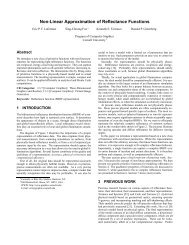pigmented colorants: dependence on media and time - Cornell ...
pigmented colorants: dependence on media and time - Cornell ...
pigmented colorants: dependence on media and time - Cornell ...
You also want an ePaper? Increase the reach of your titles
YUMPU automatically turns print PDFs into web optimized ePapers that Google loves.
scattering <strong>and</strong> absorpti<strong>on</strong> properties. The following research dem<strong>on</strong>strates the<br />
usefulness of K-M theory to simulate the appearance of <str<strong>on</strong>g>pigmented</str<strong>on</strong>g> materials.<br />
Haase <strong>and</strong> Mayer introduced the Kubelka-Munk model to computer graphics,<br />
using the K-M equati<strong>on</strong>s for rendering <strong>and</strong> color mixing in both interactive <strong>and</strong><br />
offline applicati<strong>on</strong>s [HM92]. The work included a simple airbrush tool, where users<br />
could work with real-world <str<strong>on</strong>g>pigmented</str<strong>on</strong>g> paints, instead of arbitrary RGB colors.<br />
The program stored <strong>and</strong> updated the current K <strong>and</strong> S values for every pixel in<br />
the image, using a custom four-wavelengths representati<strong>on</strong> based <strong>on</strong> Meyer’s previ-<br />
ous work [Mey88]. The four-wavelength encoding was based <strong>on</strong> integrating against<br />
the human visual resp<strong>on</strong>se functi<strong>on</strong>s in ACC color space. The interpolati<strong>on</strong> of the<br />
wavelengths used to compute tristimulus values from spectral data was d<strong>on</strong>e using<br />
Gaussian quadrature. Computing reflectance values for K <strong>and</strong> S values over the<br />
entire visible spectrum is very computati<strong>on</strong>ally expensive, <strong>and</strong> therefore limiting<br />
the wavelength informati<strong>on</strong> is necessary for the purposes of real-<strong>time</strong> interacti<strong>on</strong>.<br />
Since the reflectance spectral curves are reas<strong>on</strong>ably smooth functi<strong>on</strong>s, the errors<br />
caused by this minimal sampling are minimized.<br />
The results of this theory are illustrated in Figure 4.6. A real photograph<br />
painted with varying c<strong>on</strong>centrati<strong>on</strong>s of two red paints <strong>and</strong> a white paint is simu-<br />
lated using RGB values <strong>and</strong> Kubelka-Munk theory. The spectral reflectances of<br />
the paints are shown in Figure 4.7 <strong>and</strong> the dependencies of the absorpti<strong>on</strong> <strong>and</strong><br />
scattering coefficients are shown in Figure 4.8.<br />
Curtis et al. used the Kubelka-Munk equati<strong>on</strong>s for optically compositing thin<br />
glazes of paint in their watercolor simulati<strong>on</strong> [CAS + 97]. The model uses a three<br />
wavelength RGB representati<strong>on</strong> for the K <strong>and</strong> S coefficients. The K <strong>and</strong> S values<br />
107<br />
were not determined experimentally, but specified interactively. This method of



